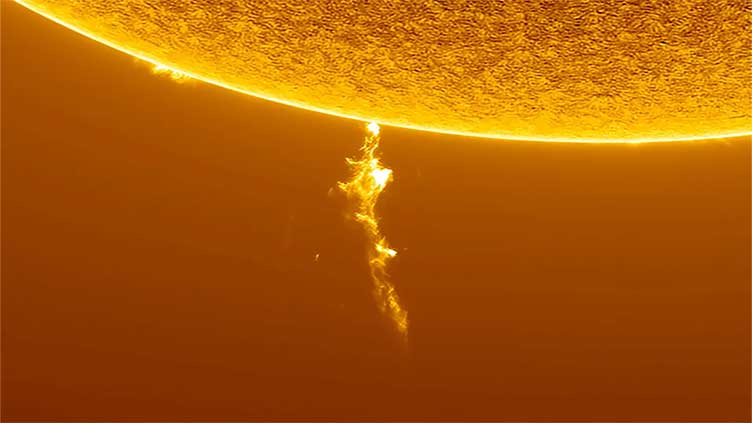Pics show burning of 200,000-km high wall of Sun plasma

Technology
There was significant turbulence
(Web Desk) - A jaw-dropping image of a burning 200,000km high wall of Sun plasma has been captured by an astrophotographer.
Eduardo Schaberger Poupeau, 50, snapped the amazing spectacle that shows blazing gas errupting from the sun's 5600,C surface.
He said: "Aside from enduring the very high temperatures of our summer, there was significant turbulence and cloud cover frequently interrupting my work.
"Nevertheless, it was truly a wonderful spectacle, undoubtedly worth the effort.
He added that the main difficulty he faced when aiming to take the high resolution shot is atmospheric turbulence.
Eduardo said this causes the image to "shake" and even appear to "boil" at times.
"This turbulence is further magnified when attempting to photograph the sun, as it heats not only the surface but also the various layers of air as it rises above the horizon," he continued.
"To minimise this issue, I employed the technique known as "Lucky Imaging," which involves capturing sequences of videos with numerous frames, hoping to "luckily" coincide with moments of stability.
"Subsequently, I stacked between 70 and 100 of these frames to reduce digital noise in the image."
Eduardo also described how the remarkable picture wasn't just taken on a whim but was a result of a life-long fascination with "the vast universe and its mysteries."
"I grew up contemplating the night sky, imagining the wonders hidden among the stars," he said.
The astrophotographer sees it as a "privilege" that he is able to capture "the beauty of the solar system" with his own equipment.
He concluded saying: "Each photography session is an encounter with the sublime, where the immense sunspots, the filaments dancing on its surface, and the prominences rising thousands of kilometers reveal the magnificence and power of the sun."
It comes as the European Space Agency faced a tense wait for an old satellite to plummet back to Earth this week.
What remained of its ERS-2 satellite eventually crashed into the Pacific Ocean, an event that's set to become more common with the increase in satellites being sent to space.
Space debris expert Professor John L. Crassidis spoke with The U.S. Sun about the dangers associated with debris and whether falling space junk is an increasing threat.


